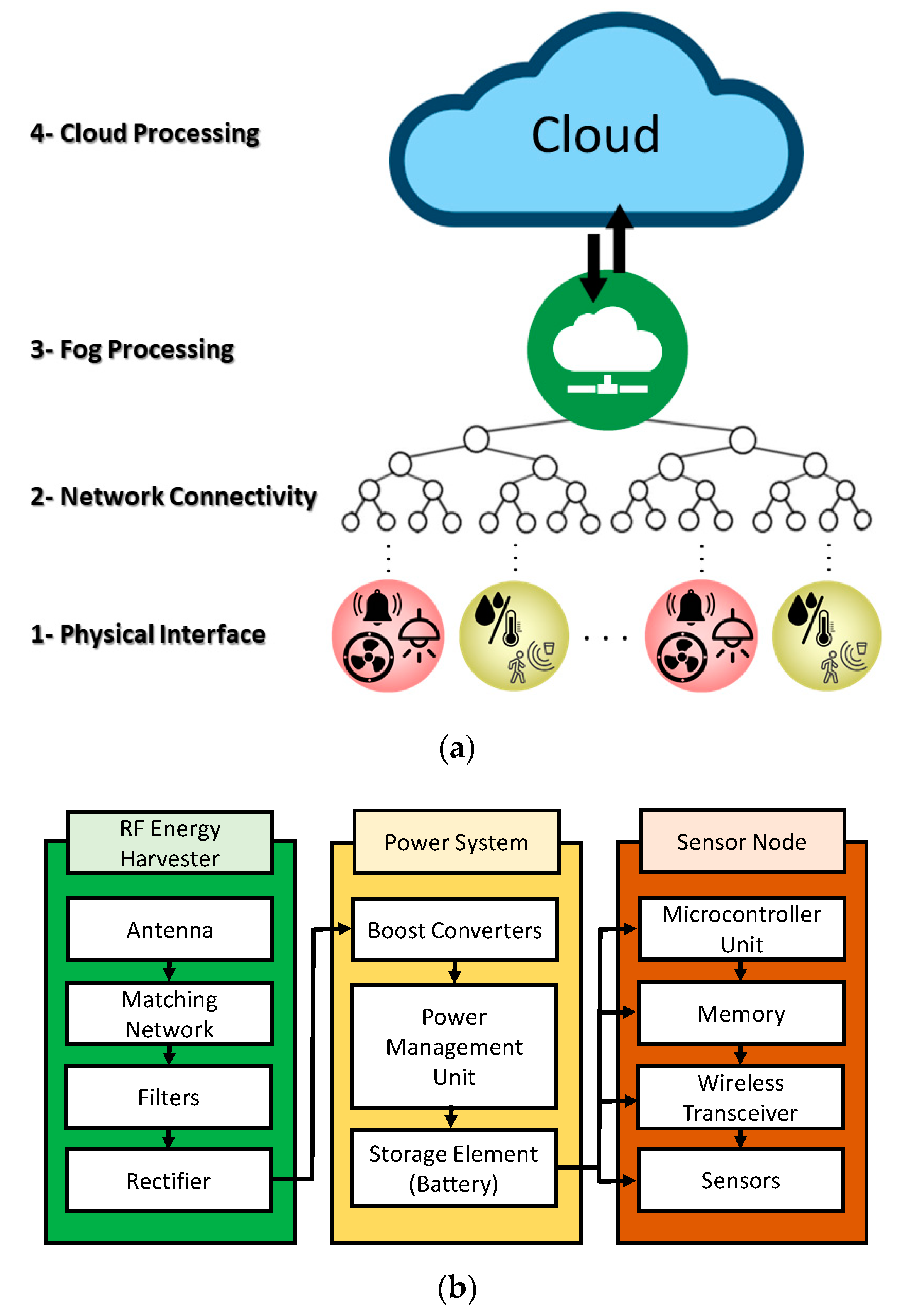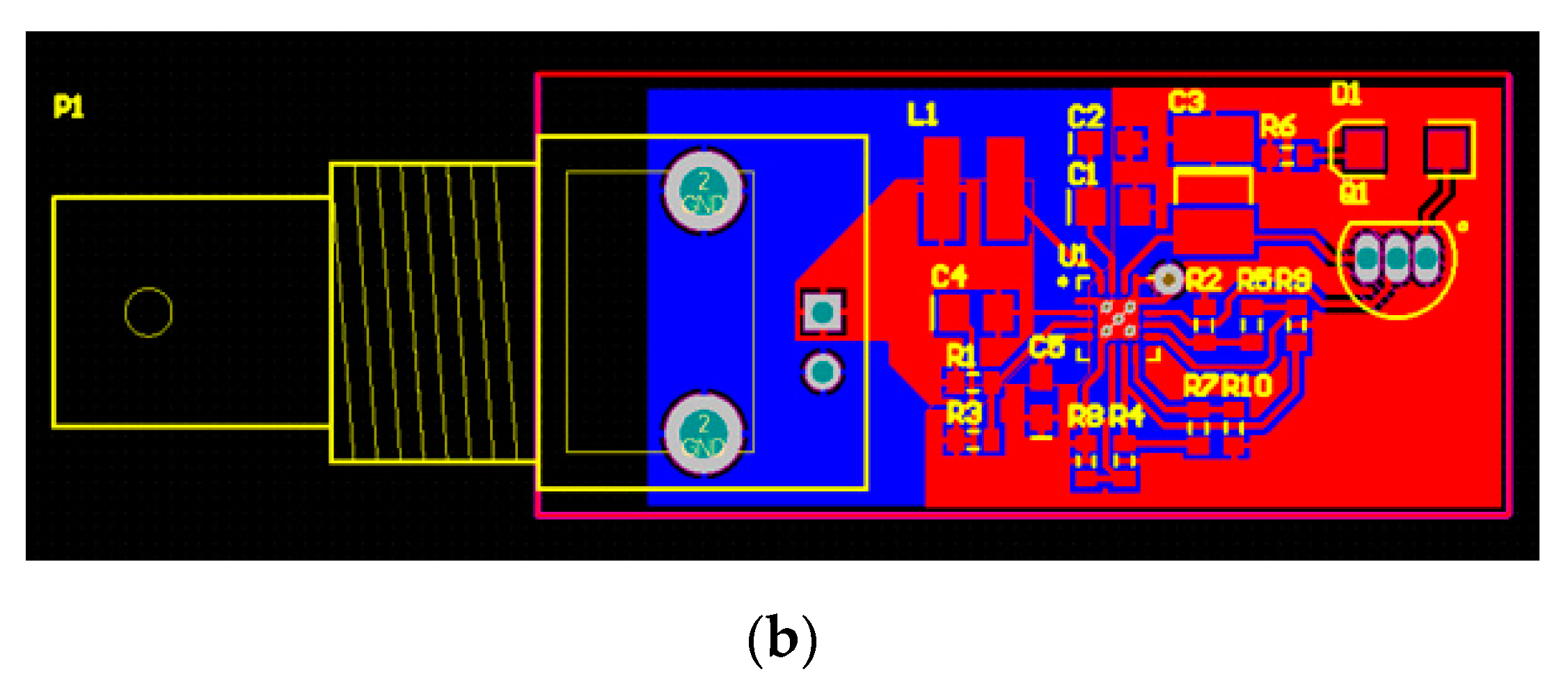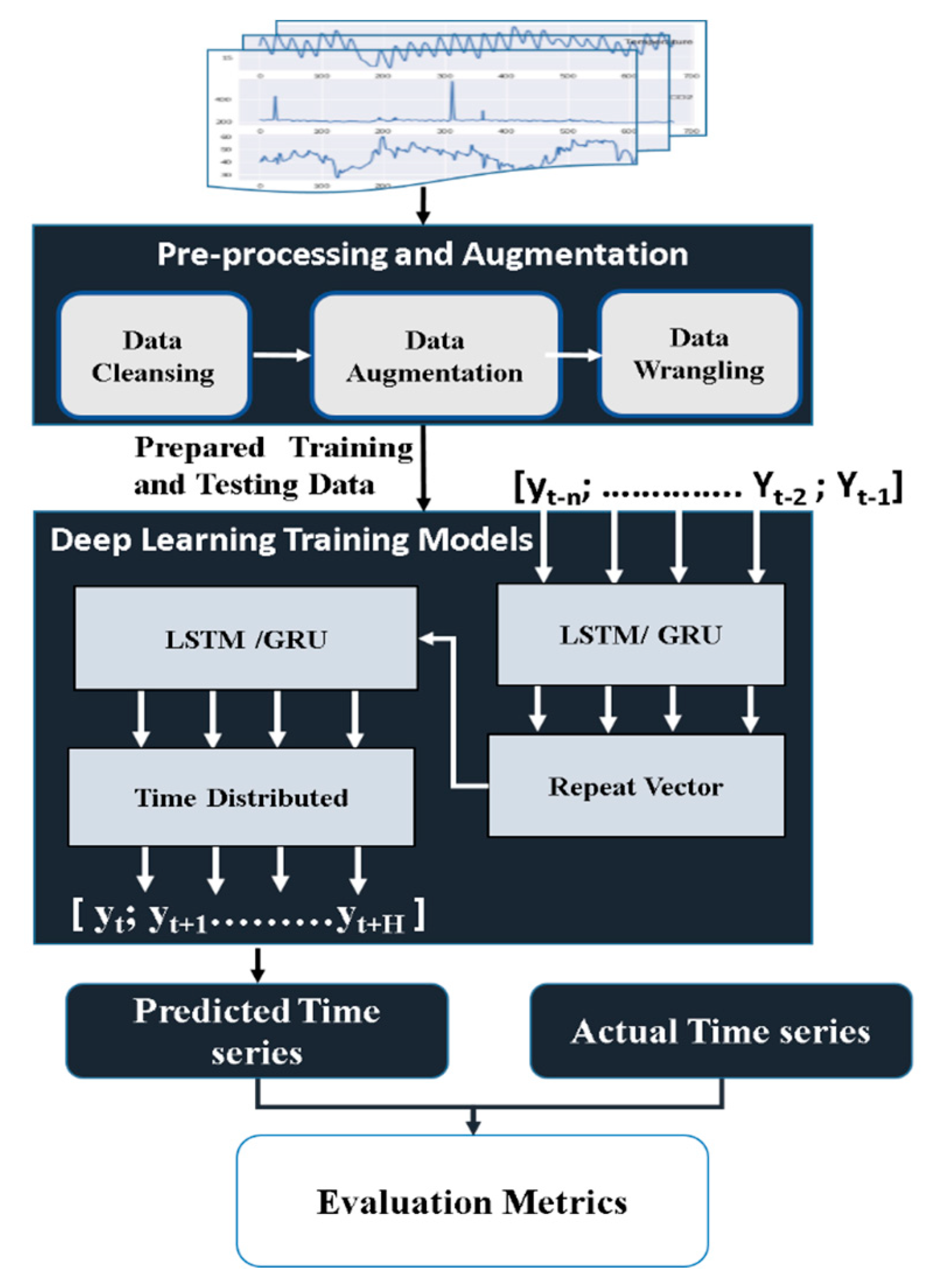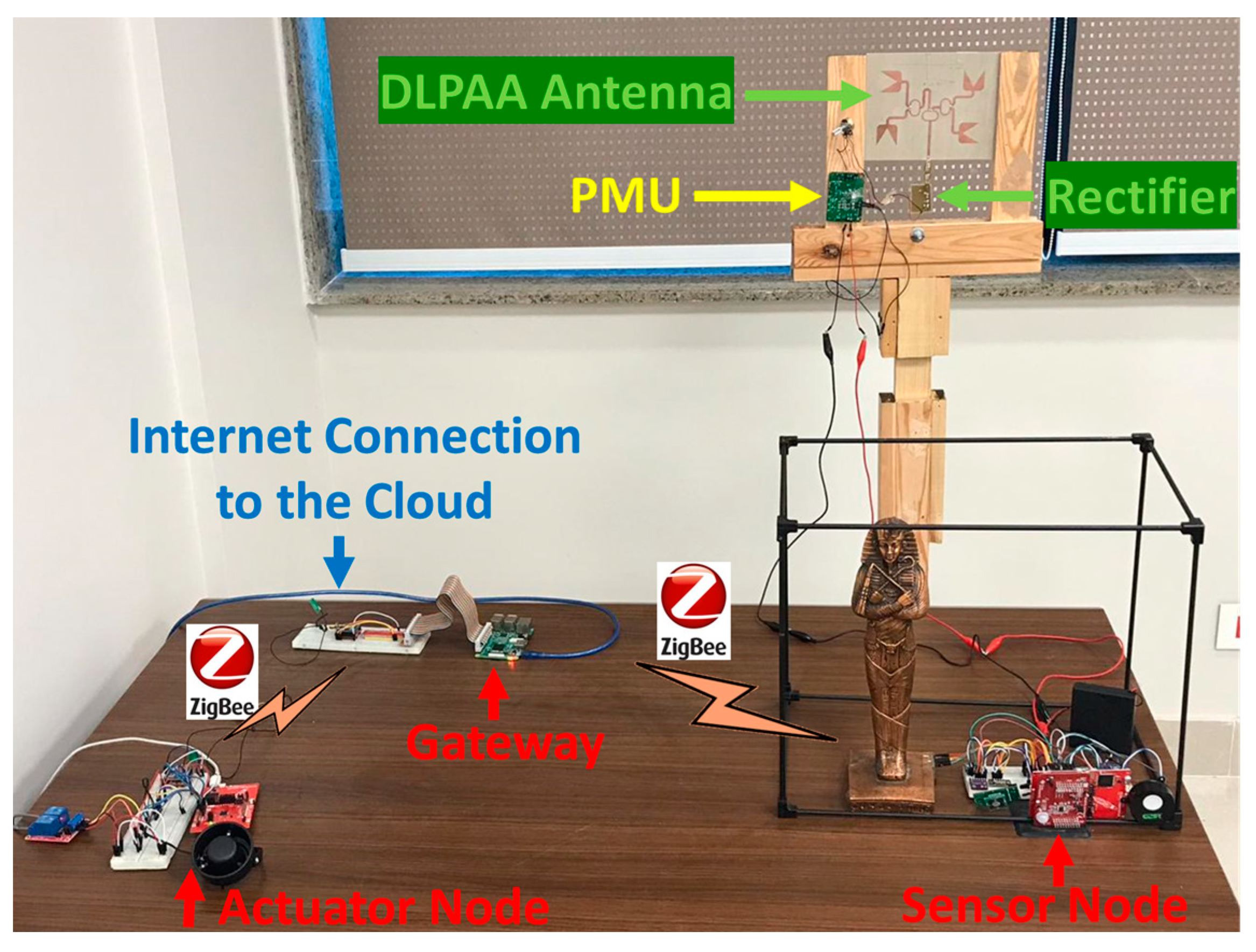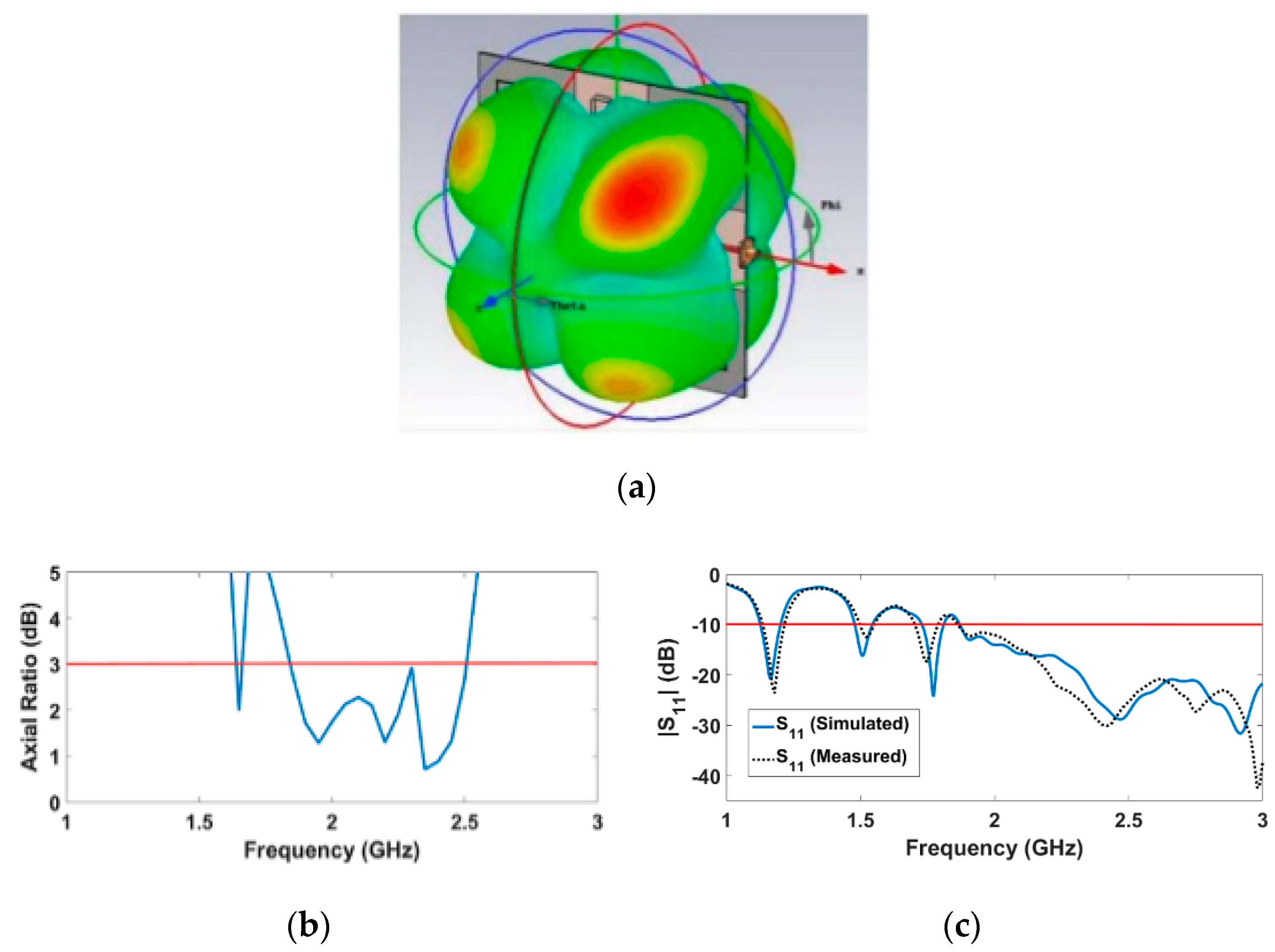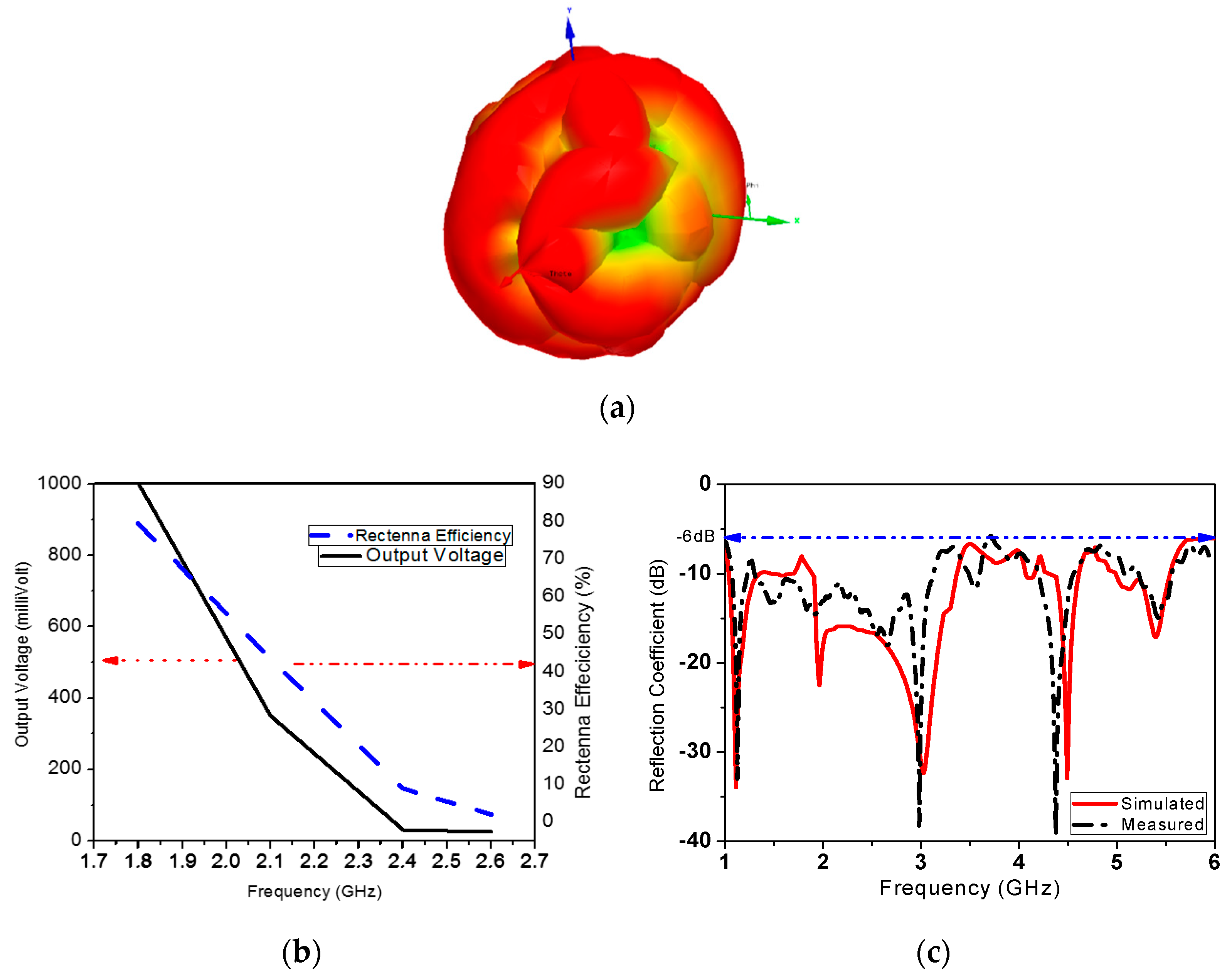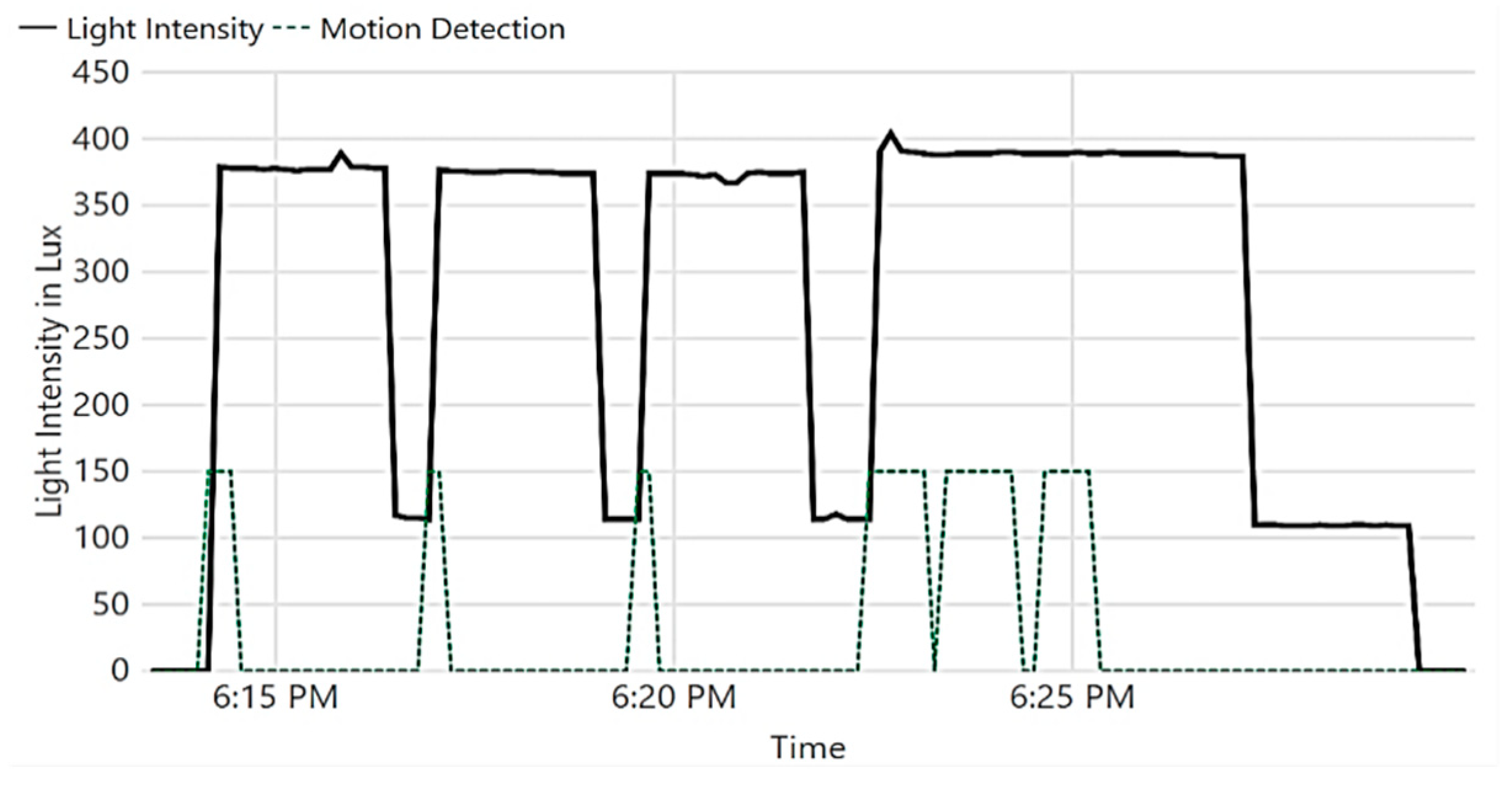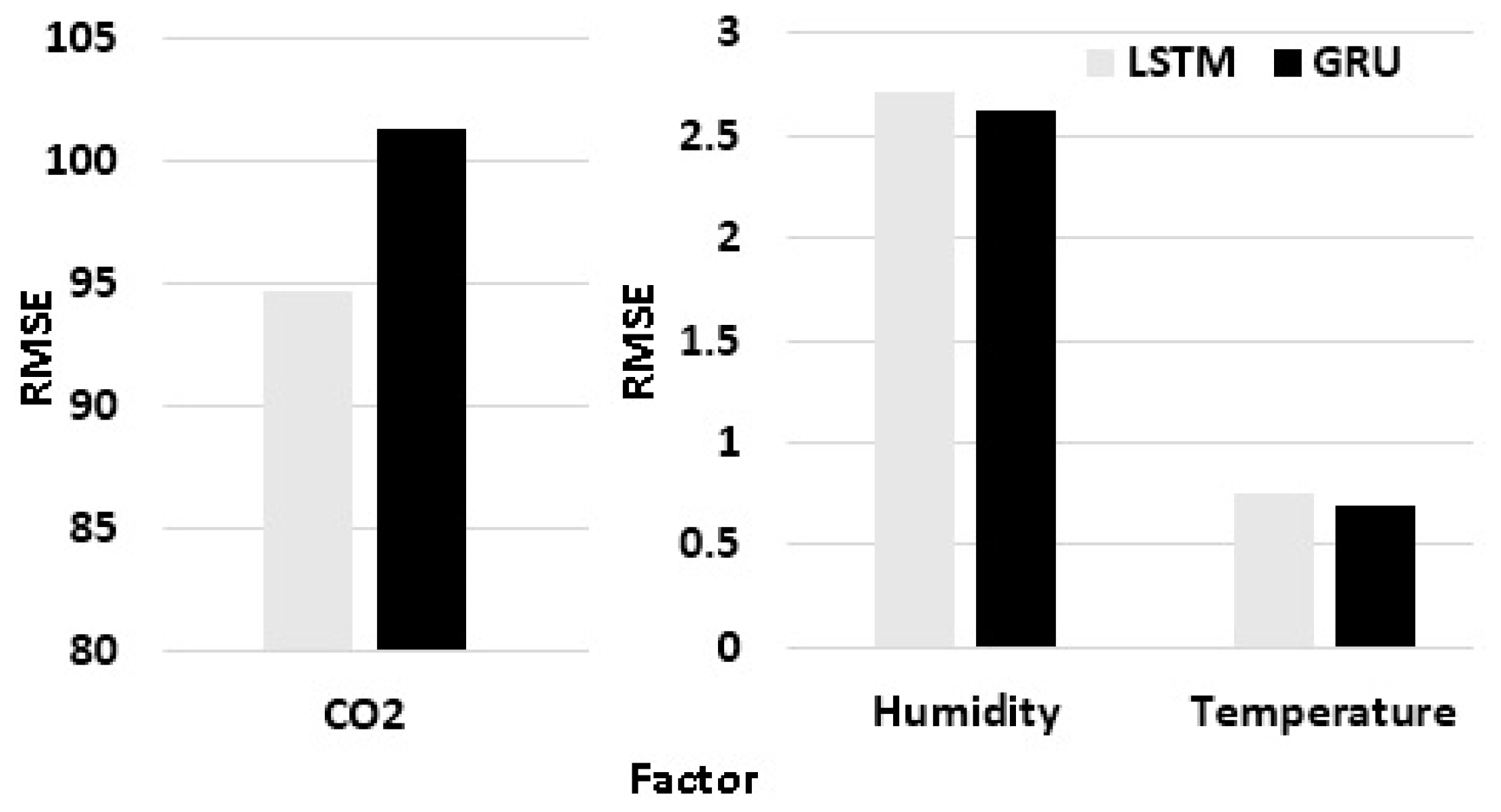We build a prototype of the overall system that integrates all of its components, as shown in
Figure 7. In this section, we present the experimental results that demonstrate the performance of the different components of the proposed museum control system.
3.1. RF Energy Harvesting Performance
The 3-D radiation pattern for the circularly polarized antenna array is shown in
Figure 8. Four similar lobes can be noticed in the array pattern. Each element radiates according to its orientation and excited phase. The four lobes are directed towards +45°, +135°, –45°, and –135° with 30.5° angular width. Note that the single element has two lobes directed towards 0° and 180° with 87° angular width. Therefore, the array is more favorable in situations where the direction of the source is unknown and changing, as is the case with the considered scenario. In order to check the CP operation of the array, the axial ratio was calculated. The achieved axial ratio as a function of frequency is illustrated in
Figure 8. This topology significantly enhances the axial ratio bandwidth (670 MHz) from 1.84 GHz to 2.51 GHz. A reflection coefficient of −28.39 dB was achieved at 2.45 GHz, as shown in
Figure 8c.
The gain, directivity, and radiation efficiency of the array are 3.29 dBi, 5.669 dBi, and 57.87%, respectively, at 2.45 GHz. The low radiation efficiency is attributed to the used substrate material, which is commercially available and has low cost at the expense of high dielectric loss. The gain variation of the 2 × 2 array is shown in
Figure 9. It is worth noting that the total array gain is quite low, since each element is radiating in a specific direction. This case is desirable for ambient RF energy harvesting applications, since the positions of source and receiving antenna are relatively uncertain and consequently this array can collect signals from various directions simultaneously, when it is used as the receiving antenna in a rectenna structure.
Circular polarized rectennas are used due to their ability to obtain constant DC power at random polarization angles. However, to avoid 3dB CP loss, the DLPAA is used in our system, keeping the two main directions for maximum receiving power. Moreover, the Schottky SMS 7630 diode shows better performance with lower losses than HSMS 2860.
The horizontally polarized (H-pol) and vertically polarized (V-pol) gain of the DLPAA in a broadside direction are shown in
Figure 10 The average gain is around 5.5 dBi for both V-pol and H-pol. The gain values of the antenna array at the frequencies correspond to the different wireless communication standards (GSM 1800, digital TV, Wi-Fi, and LTE) listed in
Table 2. The average radiation efficiency of the designed DLPA array is about 95% over the operating band, as shown in
Table 2. It was noticed that at different wireless communication frequencies, the H-pol and V-pol gains in the broadside direction are approximately the same.
To examine the received power of the designed single monopole element and DLPAA at certain frequencies, a DRG horn antenna (SAS-571) is used as a transmit antenna and an Anritsu MS27260 spectrum analyzer is used to measure the received power on the antenna element and the array for both vertical and horizontal polarizations. The input power of the transmit horn is 3 dBm two meters away from the receive antenna.
Table 3 lists the received RF power in dBm for both the single element and antenna array. The received power for V-pol and H-pol of the antenna array are almost the same in the frequency bands of interest. The 3-D radiation pattern for the DLP array rectenna in all directions is shown in
Figure 11a. The output voltage and efficiency of the system rectenna at different operating frequencies is shown in
Figure 11b. The DLPAA achieves the maximum harvested voltage for the proposed system, which is 1000 mV, as shown in
Figure 11b. It is achieved at 1.8 GHz with −9.1 dBm RF received power from a dedicated horn antenna source. A reflection coefficient of -18 dB has been achieved at 2.45 GHz, as shown in
Figure 11c.
Table 4 gives a comparison between the RF energy harvesting system proposed in this paper and the literature [
51,
52,
53,
54,
55].
Table 4 shows that our proposed RF energy harvesting system has a larger number of covered frequency bands, reduced size, higher rectenna efficiency, higher RF sensitivity, and superior operation, as compared to different types of polarization techniques.
3.3. IoT System Performance
Here, we present the results obtained by implementation of a prototype using the IoT system design described in
Section 4. First, we assess the lifetime of the node, and then present a set of experiments demonstrating the overall system performance.
The lifetime of the IoT system is limited by the lifetime of the sensor node, as it is the only battery-powered component in the system. To evaluate the lifetime of the sensor node, we measured power consumption in different power modes. The node has two power modes: sleep mode and active mode. In the sleep mode, the node consumes on average 2.5 mA. In the active mode, the node operates in three states, depending on which hardware elements and sensors are currently active. The current consumptions of the identified three active states are 50, 31.8, and 21 mA. Every time the node wakes up and enters the active mode, it takes only 0.5 second to collect sensor measurements and send them over the network to the gateway. The sensor node is powered by three of the used 1200 mAh LiFePO4 batteries with output voltage around 3.2 V to increase the current capacity to match the difference between the average RF energy harvesting rate and the high power consumption of the node when active. The lifetime of the node is 50.08 days, compared to 9.8 days in [
11] and 20 hours in [
2].
Table 5 presents a comparison of the proposed system with the closely related literature. It shows the extended lifetime of the system; despite the many functionalities it provides.
Both antenna arrays (CP and DLPAA) are integrated with the sensor node through the PMU. The DLPAA array exhibits a charging rate of 1.8 mV/sec, which charges a 1F super-capacitor and 3.3 V 1600 mAh unloaded battery to 2 V in 19 min and 27 days, respectively. Meanwhile, the CP array shows a charging rate of 1.2 mV/sec, which charges a 1F super-capacitor and 3.3 V 1600 mAh unloaded battery to 2 V in 28 min and 39 days, respectively. Based on the power consumption of the sensor node, the proposed system is self-powered by charging its battery (or even using a super-capacitor) from the ambient RF energy, but not on the fly. This significantly extends the 50.08-day lifetime, when the node’s battery is continuously charged with the rates mentioned above.
Next, we validate the IoT system’s capabilities to control the museum’s ambience. In the first experiment, we show how light is autonomously controlled based on the current visitor occupancy of a museum section. The results of the experiment are shown in
Figure 14. At 6:14 pm, a visitor entered the section, causing light intensity to be changed to 380 Lux; he stood still for about two minutes. At 6:16 pm, the lights turned to dim (120 Lux), as no further movement was detected for 2 min (mean visitor standing time
Tmean). At 6:17 pm, when the visitor moved, the lights turned to 380 Lux again. Several visitors entered the area at 6:22 pm, causing consequent movement detections. When the visitors left the room at 6:25 pm, the lights were kept at 380 Lux for 2 min, then at 120 Lux for another 2 min, before being totally turned off. It is worth mentioning that
Tmean is configurable, and it is set to 2 min only for demonstration purposes.
Another experiment was performed to demonstrate the IoT system’s ability to keep the temperature in the museum at a desired range, as shown in
Figure 15. Note that rapid change in temperature is harmful to artifacts [
1].
Initially, the temperature was intentionally increased, and the system turned on to monitor the temperature and control the operation of the air cooler. The air cooler was turned on until the temperature fell below 18 ℃ at 12:46 pm; the air cooler was then turned off, causing the temperature to increase. When the temperature passed 20 ℃ at 1:00 pm, the air cooler was turned on again.
3.4. Time Series Prediction Performance
We evaluate the performance of the proposed prediction framework using only readings of environment attributes that are measured more frequently, such as temperature, humidity, and CO2 sensors. Predicting the data of other sensors (PIR and touch detection) is not applicable, since these events are spontaneous. The proposed time series prediction system was trained and evaluated using the dataset collected by our sensor node. This dataset contains readings that are collected every one hour from temperature, humidity, and CO2 sensors over a period of 120 days. The data is then divided into 100 days for training and 20 days for testing. The collected data is uploaded into MySQL database on a cloud for more processing and prediction sequences. The reported experiments were conducted on Google Colab with K80 GPU and 12 GB memory. The proposed approach was designed with tensorflow and keras using a python environment on Linux platform. To validate the performance of the proposed framework for time series prediction, we calculated MAE and RMSE. Two models considering different input factors were trained. The first model input consists of target factor, day hour, and week. The second model’s input consists of humidity, temperature, CO2, day hour, and week day.
Table 6 presents the MAE and RMSE models of the predicted indoor CO
2, temperature, and humidity on the testing dataset using original data. It illustrates that the best performance is obtained by the MAE (Model 1), considering the pattern of data for weekends, and working and non-working hours. Therefore, we will consider this model only with the augmented data, considering that date-time features reduce the RMSE for CO
2 by more than 50% and for humidity by more than 10%, with slight enhancement in temperature RMSE, compared to [
13].
Applying the data augmentation step generates 140 days of data; the generated data is then concatenated with the original one.
Table 7 represents the MAE and RMSE of Model 1 for the predicted indoor CO
2, temperature, and humidity on the testing dataset using augmented data. From the depicted experimental results in
Table 6, it is concluded that using the data augmentation approach improves the performance of LSTM and GRU deep learning models by decreasing the RMSE by approximately 2.54% for CO
2, 23.82% for temperature, and 2.59% for humidity, compared to [
13].
Figure 16 shows that the LSTM deep learning model outperforms GRU for CO
2, while the GRU model outperforms for temperature and humidity. This is due to the nature of the time series pattern for CO
2, which is seriously affected by the number of occupants on weekends.
